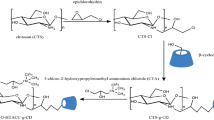Abstract
This study examined the adsorption of a synthetic cutting fluid and cutting fluid effluent on chitosan and SDS-modified chitosan. Chitosan and SDS-modified chitosan were prepared in form of beads and fibers. A series of batch experiments were carried out as a function of the initial concentration of cutting fluid, contact time and pH of the fluid. The contact angle study suggested that the SDS-modified chitosan was more hydrophobic than chitosan. The Zeta potential study showed that chitosan, SDS-modified chitosan and synthetic cutting fluid had a point of zero charge (PZC) at pH 7.8, 9 and 3.2, respectively. SDS-modified chitosan has a greater adsorption capacity than chitosan. The experimental results show that adsorption capacity of the cutting fluid on 1.0 g of SDS-modified chitosan at pH 3 and for a contact time of 120 min was approximately 2,500 g/kg. The adsorption capacity of chitosan and SDS-modified chitosan increased with decreasing pH. The Langmuir, Freundlich, and Brunauer Emmett and Teller (BET) adsorption models were used to explain the adsorption isotherm. The Langmuir isotherm fitted well with the experimental data of chitosan while the BET isotherm fitted well with the SDS-modified chitosan data. Pseudo first- and second-order kinetic models and intraparticle diffusion model were used to examine the kinetic data. The experimental data was fitted well to a pseudo second-order kinetic model. The significant uptake of cutting fluid on chitosan and SDS-modified chitosan were demonstrated by FT-IR spectroscopy, SEM and heat of combustion.
Similar content being viewed by others
Abbreviations
- a :
-
BET constant
- A :
-
Langmuir constant
- B :
-
Langmuir constant
- c :
-
concentration of cutting fluid at equilibrium stage [g/m3]
- C :
-
concentration of cutting fluid remaining in solution
- C e :
-
equilibrium concentration of cutting fluid [g/m3]
- C o :
-
initial cutting fluid concentration [g/m3]
- C s :
-
saturation concentration of cutting fluid [g/m3]
- e 1 :
-
correction in calories for heat of formation of nitric
- e 2 :
-
correction in calories for heat of formation of sulfuric
- e 3 :
-
correction in calories for heat of formation of fuse wire [J]
- H g :
-
gross heat of combustion [J/g]
- K :
-
Freundlich constant
- k 1 :
-
rate constant of pseudo first-order adsorption [1/min]
- k 2 :
-
rate constant of pseudo second-order adsorption [kg/gmin]
- k i :
-
intraparticle diffusion rate constant (g/kg-min0.5)
- m :
-
weight of adsorbent [kg]
- M :
-
weight of sample [g]
- n :
-
Freundlich constant
- q e :
-
adsorption capacity [g/kg]
- q t :
-
amount of adsorption at time t [g/kg]
- R 2 :
-
correlative coefficient
- R L :
-
separation factor
- t :
-
time [minute]
- T :
-
net corrected temperature rise [K]
- V :
-
volume of cutting fluid [m3]
- W :
-
energy equivalent of calorimeter [J/K]
- x :
-
amount of cutting fluid adsorbed [kg]
- x m :
-
amount of cutting fluid adsorbed corresponding to complete monolayer coverage [g/kg]
References
J. Marchese, N. A. Ochoa, C. Pagliero, and C. Almandoz,Environ. Sci. Technol.,34, 2990 (2000).
G. Ríos, C. Pazos, and J. Coca,Colloid Surface A,138, 383 (1998).
A. Y. Hosny,Sep. Technol.,6, 9 (1996).
N. Moulai Mostefa and M. Tir,Desalination,161, 115 (2004).
M. Belkacem, H. Matamoros, C. Cabassud, Y. Aurelle, and J. Cotteret,J. Membrane Sci.,106, 195 (1995).
P. Janknecht, A. D. Lopes, and A. M. Mendes,Environ. Sci. Technol.,38, 4878 (2004).
J. R. Portela, J. López, E. Nebot, and E. Martínez de la Ossa,J. Hazard. Mater.,88, 95 (2001).
T. Viraraghavan and G. N. Mathavan,Oil Chem. Pollut.,4, 261 (1988).
C. Solisio, A. Lodi, A. Converti, and M. D. Borghi,Water Res.,36, 899 (2002).
B. C. Son, K. Park, S. H. Song, and Y. J. Yoo,Korean J. Chem. Eng.,21, 1168 (2004).
S. E. Bailey, T. J. Olin, R. M. Bricka, and D. D. Adrian,Water Res.,33, 2469 (1999).
V. M. Boddu, K. Abburi, J. L. Talbott, and E. D. Smith,Environ. Sci. Technol.,37, 4449 (2003).
J. R. Evans, W. G. Davids, J. D. MacRae, and A. Amirbahman,Water Res.,36, 3219 (2002).
C. Jeon and W. H. Hll,Water Res.,37, 4770 (2003).
W. S. Wan Ngah, C. S. Endud, and R. Mayanar,React. Funct. Polym.,50, 181 (2002).
A. R. Cestari, E. F. S. Vieira, A. G. P. dos Santos, J. A. Mota, and V. P. de Almeida,J. Colloid Interf. Sci.,280, 380 (2004).
M.-S. Chiou, P.-Y. Ho, and H.-Y. Li,Dyes and Pigments,60, 69 (2004).
A. L. Ahmad, S. Sumathi, and B. H. Hameed,Water Res.,39 2483 (2005).
A. L. Ahmad, S. Sumathi, and B. H. Hameed,Chem. Eng. J.,108 179 (2005).
S. Pongstabodee, K. Piyamongkala, and L. Mekasut, Thai Patent No.0601004582.
X. Zhang and R. Bai,J. Colloid Interf. Sci.,264, 30 (2003).
A. I. Zouboulis and A. Avranas,Colloid Surface A,172, 153 (2000).
J. M. Montgomery,Water Treatment Principles and Design, John Wiley and Sons, Inc., New York, 1985.
L. D. Benefield, J. F. Judkins, and B. L. Weand,Processes Chemistry for Water and Wastewater Treatment, Prentice-Hall, Inc., Englewood, 1982.
D. L. Pavia, G. M. Lampman, and G. S. Kriz,Introduction to Spectroscopy, 3ed, Harcourt College Publishers, Orlando, 2001.
Author information
Authors and Affiliations
Rights and permissions
About this article
Cite this article
Piyamongkala, K., Mekasut, L. & Pongstabodee, S. Cutting fluid effluent removal by adsorption on chitosan and sds-modified chitosan. Macromol. Res. 16, 492–502 (2008). https://doi.org/10.1007/BF03218550
Received:
Revised:
Accepted:
Issue Date:
DOI: https://doi.org/10.1007/BF03218550




